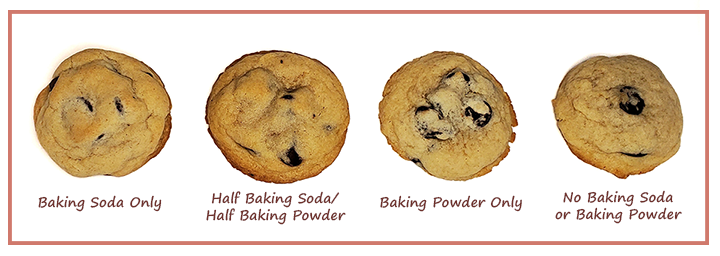Experiment: Baking Soda vs. Baking Powder
Baking soda and baking powder are both chemical leaveners, substances that react to produce carbon dioxide gas when exposed to other ingredients in a recipe. Since the carbon dioxide is trapped within the dough, it causes the dough to expand and rise as gas bubbles form. This results in the soft, aerated texture you see in baked goods such as cookies, cakes, and quickbreads.
I conducted an experiment to see how baking soda and baking powder differently affect chocolate chip cookies. But before we get to the results of the experiment, let’s go over some basics about both baking soda and baking powder.
Baking Soda
Baking soda, or sodium bicarbonate, is an alkaline compound composed of a sodium cation and a bicarbonate anion. It produces carbon dioxide when combined with an acid. This reaction creates bubbles very quickly, so recipes that use baking soda as their primary leavener do not need to rest or proof before baking to achieve the proper rise and texture (in contrast to yeasted doughs). Baking soda is about 4 times stronger than baking powder.
Baking Powder
Baking powder is made up of baking soda, an acid (usually cream of tartar), and cornstarch. Since the acid is already included, baking powder is primarily used in recipes that do not have another acidic ingredient. There are two common types of baking powder. Single acting creates carbon dioxide bubbles when it comes in contact with a liquid. Double acting has two leavening periods, the first when the baking powder is exposed to moisture, and the second when heated during baking.
To make your own baking powder you can use the following equation:
1 tsp baking powder = 1/3 tsp baking soda + 2/3 tsp cream of tartar
Experiment Setup
To practically show how the differences between baking soda and baking powder present in a baked good, I decided to use the delicious and universally known chocolate chip cookie. Using the Nestle Toll House recipe (yes, the one on the back of the chocolate chip bag) as a starting point, I made the following four batches of cookies:
Baking soda only (original recipe)
Baking powder only
Half baking soda, half baking powder
No baking soda or baking powder
For cookies 1, 2, and 3, the total amount of chemical leavener remained constant. All other ingredients and conditions were kept the same.
Let’s take a look at the results!
Results
Baking Soda Only: These cookies came out as I expected from the Nestle Toll House recipe - crispy outside, soft and gooey inside. These cookies rose the most when compared to others in the experiment, as expected, due to the baking soda reacting with the acidic brown sugar in the recipe.
Half Baking Soda/Half Baking Powder: Not surprisingly, these cookies were the closest to the original recipe. They did not rise quite as much as the cookies with only baking soda, but they still had a soft interior.
Baking Powder Only: These cookies show just how different baking soda and baking powder are when used in a chocolate chip cookie. They did not rise nearly as much as the cookies with baking soda, causing a more dense interior.
No Baking Soda or Baking Powder: These were the most dense cookies of the bunch. They did not spread out as much as the others and didn’t have the added rise from a chemical leavener, resulting in a very chewy and tough texture. However the taste was still decent - it is hard to go wrong with butter, sugar, and chocolate!
Final Thoughts
Can you swap baking soda and baking powder in a chocolate chip cookie recipe? I wouldn’t recommend it. Recipes are formulated as a whole, taking into account all ingredients and the reactions that occur between them. Swapping baking soda for baking powder (or vice versa) will not produce the intended results.








